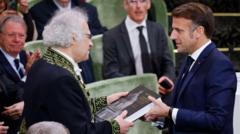The completion of this dictionary’s ninth edition marks a pivotal moment, replacing the previous edition finalized in 1935. While it features 21,000 new entries as a reflection of the evolving language from the 1950s onward, linguists argue its relevance is dwindling. Critics point out that the dictionary's compilation speed is inadequate for capturing the rapid shifts in contemporary language use, with many modern terms, such as "insta," "smartphone," and "vlog," notably absent.
Despite adding some terms to recognize gender inclusivity in job titles, several definitions remain outdated, encapsulating traditional views that no longer align with societal changes — for example, defining marriage strictly as a union between a male and a female. As noted by critics, "How can this collection serve as a reference?" in an age where online dictionaries are more expansive and frequently updated.
Led by writer Amin Maalouf, the academy convenes weekly to discuss and adjudicate proposed definitions. One member, English poet Michael Edwards, even advocated for reviving obsolete words like “improfond” to enhance the language, although his suggestion didn’t gain traction. As discussions of a tenth edition begin, the challenge of maintaining the language’s essence while adapting to modern dynamics continues.
Despite adding some terms to recognize gender inclusivity in job titles, several definitions remain outdated, encapsulating traditional views that no longer align with societal changes — for example, defining marriage strictly as a union between a male and a female. As noted by critics, "How can this collection serve as a reference?" in an age where online dictionaries are more expansive and frequently updated.
Led by writer Amin Maalouf, the academy convenes weekly to discuss and adjudicate proposed definitions. One member, English poet Michael Edwards, even advocated for reviving obsolete words like “improfond” to enhance the language, although his suggestion didn’t gain traction. As discussions of a tenth edition begin, the challenge of maintaining the language’s essence while adapting to modern dynamics continues.






















